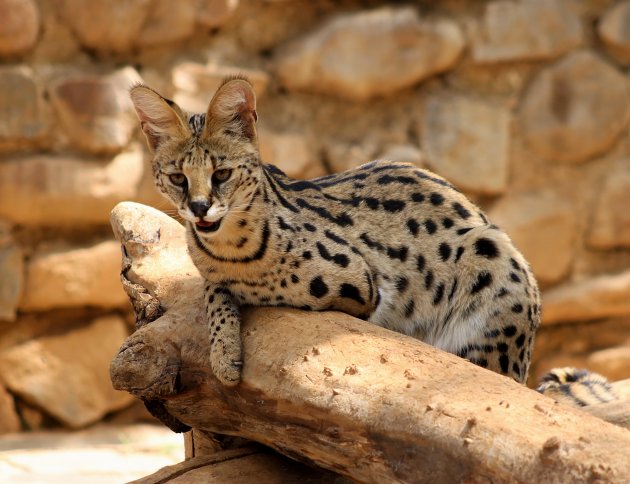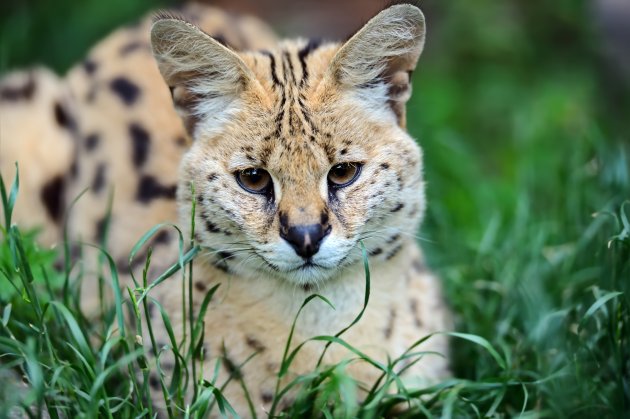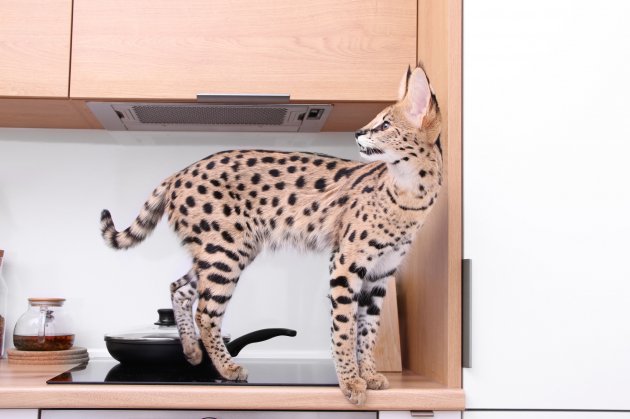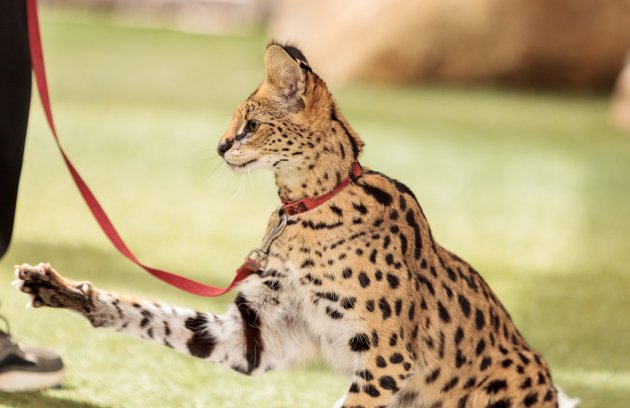The serval cat is native to Africa where it hunts its prey in the tall grasses. They resemble the Cheetah, except they have shorter tails.
This beautiful cat was appreciated by the Ancient Egyptians, who kept them as pets - we know this as the serval is depicted in their artwork. However, this feline is not considered to be domesticated. Although breeding stock servals were imported into the US over a century ago, the servals today have many generations between them and their wild roots.
Do you think a serval is a right cat for you? Read on for important information on keeping the serval cat as a pet.

The Appearance of the Serval
The serval is a medium-sized cat with a gorgeous golden yellow to buff coat that is dotted, spotted, and striped in black. This feline is slender and tall with long legs, elongated feet, and a 16-inch tail.
The neck of this animal is slim and its head is small (in comparison to the rest of its body). The black ears are super-large and rounded with a distinguishing white stripe across the center. Its almond-shaped eyes are set low on its head and its muzzle is well-defined.
- Serval Fast Facts
- Weight: 15 to 40 pounds
- Length: 2.7 feet
- Height: Up to 24 inches at the shoulder
- Lifespan: 15 to 25 years
- Native: Africa
The Behavior of the Serval
In the wild, serval cats use their large ears and long neck and legs to detect and hunt their prey. And like all good cat hunters, the serval is patient, waiting upwards of 15 minutes with eyes closed and ears tuned into the tiniest sound. Once this wild feline has targeted its prey, it uses a vertical “hop,” that is distinctive to the species and can reach heights of four feet off the ground. If their prey is not killed on the initial attempt, the serval will continue to make several stiff-legged jumps on the prey to rectify the situation.
To flush prey from the tall grasses, the serval will bound in a zig-zag pattern, and leap high into the air.
Both male and female servals have a large territory which can range up to 11 miles squared. They continuously mark these areas with both scent and scratches.
As one pet serval owner stated:
{My} pet serval cat “did really well with his litter habits, but still enjoyed peeing in/on things in the house. If I told him NO, he would slap me HARD. He was extremely stubborn.” {excerpt link}.
Depending on the area in which the serval is living and the prey they are hunting, they can be both nocturnal and diurnal

Housing the Serval
The serval cat is not your typical housecat. This animal will need a large completely fenced-in enclosure with barriers going a few feet into the ground (to prevent the serval from digging its way out). This cat will also need a pool of water for swimming, and for catching its prey.
Since the behavior of the serval includes, running, jumping, climbing, and hunting, your enclosure will have to include plenty of places and objects to fulfill this natural need.

Feeding a Serval
The typical canned or dry-processed cat food will not suffice for the pet serval. This animal will require fresh, raw, bone-in meat such as chicken, turkey, fish, beef, and eggs. Wild food such as rodents and birds can also be an option. For a treat, offer your serval cheese, strawberries, cherries, oranges, bananas, mac-n-cheese, lettuce, and tomatoes.
In the wild, servals can consume from one to three pounds of meat in one meal. However, a large intake one day may mean a smaller meal the next (this is normal).
Handling a Serval
The serval is not a domesticated cat and will always be viewed as a wild animal, therefore, it must be handled as such.
Servals will not do well in a home with small children, or small animals, even if your serval was hand-raised its sheer height, weight and power will be too much for children or small household pets.
Experts recommended treating a pet serval with love and respect. Yelling at a serval will only scare the animal and may damage the bond you are trying to create with it.
This animal tends to bond closely with one person and will treat him or her as its pet - you may even get a headbutt! To help the bonding process give your serval plenty of praise, treats, and playtime. Feeding the serval directly from your hand helps it gain your trust.
Experts also recommend getting down on the floor and offering your pet serval his/her favorite toy. Towering over the serval can be perceived as you being a predator which will scare your cat.
It may take time to create a loving relationship with this animal, so be patient with your new serval.
Another important thing to remember with the serval is playtime will be rough. They have strong reflexes, sharp claws, and teeth, which they use to engage in playtime activities. The serval will run, leap, scratch the furniture and bound around your home (possibly, crashing into objects), so know what you are getting when you house a serval.

Fun Serval Facts
Want to learn more about this exotic pet? Check out these fun serval cat facts!
- Wild servals can be found in grasslands, bush, dry reed beds (near water), and in the mountainous regions.
- The serval's legs and ears are considered the largest of all the species (relative to their body size).
- This cat as excellent sight, sound, and smell.
- The serval is considered a solitary animal and will only come together for breeding or when fighting over territory.
- This cat can reach speeds up to 50 mph.
- The serval can leap up to 10 feet into the air to snatch birds in flight.
- Its long curved claws are designed for snagging frogs and fish right out of the water.
- Servals communicate through hissing, cackles, purring, high-pitched chirps, growls, grunts, and meows.
- Because of their long legs and necks, the serval has been nicknamed “Giraffe Cat.”
The Serval & You
The serval is not your average housecat. Before you bring one into your life, you will first need to know whether ownership of this feline is legal in your area. You will then need to be prepared for its special requirements such as an outdoor enclosure, (with a swimming pool), a raw meat diet, and the necessary steps required to bond with your new pet.
Pet parenting a serval should not be taken lightly, so know what you’ll need before you bring that serval kitten home.
Further reading and references:
- Big Cat Rescue. State Laws Exotic Cats
- Wroclaw University of Environmental and Life Sciences. Serval – the wild cat examined at the Faculty of Veterinary Medicine.
- ResearchGate. Deon Furstenburg. Focus on the Serval (Leptailurus serval)